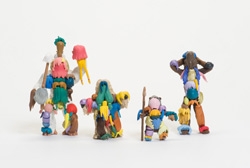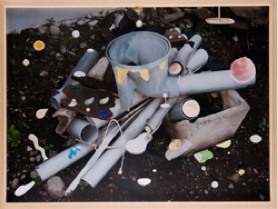The pleasure of 1 + 1 > 2
Text: Uchida Shinichi
Portrait: Nagare Satoshi
From comical yet somehow subversive works boldly combining familiar manufactured goods such as PET bottles and action figures, to a magical series wildly joining wood in a myriad of forms from driftwood to the blocks found in DIY stores, and an experiment involving cutting round the outlines on blank maps to render new topographical forms: where does Kaneuji Teppei’s expression – what one might call ‘a compulsion to connect’ – have its origins?
 Teenage Fan Club #11, 2008
Teenage Fan Club #11, 2008Plastic figures, hot glue Photo Eric, Courtesy the artist
“Take a city even,” explains the artist. “You have these sturdy structures dissolving into each other, their boundaries ambiguous, and we ourselves who live there, products of nature. In this, I sense reality in the state of things moving ahead while being simultaneously related. For me the same applies when making one of my works: a repeated removal and addition of things; I’ve even been known to surreptitiously do so to pieces already completed and on display (laughs).”
Some of Kaneuji’s creative endeavors begin with the simplest of desires. The trademark white resin covering his conglomerate creations for example began with a simple impulse to try it and see what happened.
“When I did, I found that covering things in resin produced blank spaces in their original forms: the kind of empty spaces that rather than disappearing, project a physical presence. In the wood series I’ve used wood in its natural form, timber offcuts, and fake woodblocks, but when you put them together, they start to look as if they were originally a single lump. There’s a sense that they cross back and forth between each other’s worlds…. In any case, my aim is to incorporate unexpected forms, and incalculable elements.”
Kaneuji says that the idea of taking familiar objects and sending them flying to distant places is something that occupies him a lot. Since childhood he has enjoyed playing with blocks, and putting together everyday objects. His father was a product designer, and Kaneuji junior says there were always lots of things around the house with no obvious purpose. Accordingly, rather than consciously setting his sights on becoming an artist, in a sense it was more a case of noticing that the things he wanted to do happened to go by the label of contemporary art.
“I saw works by Akasegawa Genpei for the first time at an exhibition before I started university. Faced with pieces like Can of Space (Queen Crab), it occurred to me that this was something I understood, that it was permissible to do this: a liberating sensation. I also liked music, and the art of Gerhard Richter, Mike Kelley and co. on the jackets of Sonic Youth albums also served to stimulate my interest in contemporary art.”
When working on a new piece, Kaneuji always sets himself rules, for example, to confine his chosen materials to “everyday items resembling bones” or “transparent things”. These little rules alter the meaning of the objects, blurring the boundaries between readymade items and objets d’art formed from clay by the artist.
“I don’t feel you can state unequivocally that only stuff made from scratch is any good. There are so many interesting things around us, there have to be ways to use them, and failing to do so is to my mind, unnatural. There’s a certain pleasure to be gained from the process, such as when different parts fit well together.”
 Sea and Pus (Photograph of Pipes), 2009
Sea and Pus (Photograph of Pipes), 2009Chromogenic print, collage of printed material cutouts on acrylic

Kaneuji Teppei
Born 1978 in Kyoto. Now resides in Saitama. Completed graduate course in sculpture at the Kyoto City University of Arts. Currently enjoying a growing popularity, particularly for his assemblage-like pieces made by dismantling and reconstituting existing objects and images. His major solo show Teppei KANEUJI: Melting City / Empty Forest at the Yokohama Museum of Art through May 27 presents 125 mainly new works including three- and two-dimensional pieces, and his first work using animation. The exhibition is “expected to change over its duration”.
Originally printed in ART iT 23 Spring 2009
(where the artist’s birthplace was erroneously given as Osaka instead of Kyoto. Our apologies to the artist and our readers.)
